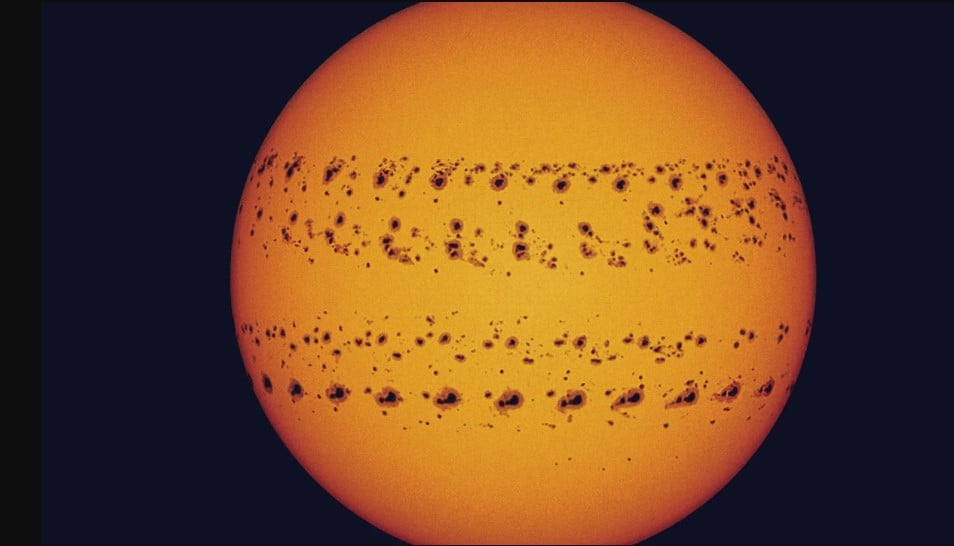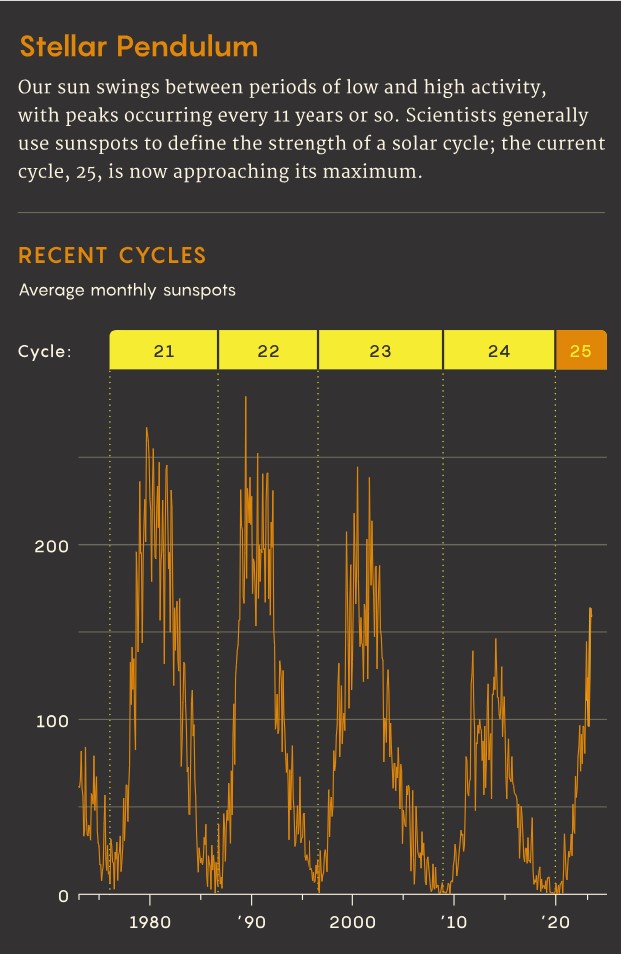Scientists have struggled to accurately forecast the strength of the sun’s 11-year cycle — even after centuries of solar observations…

The sun looks immutable, a boring celestial lightbulb that’s always turned on. But this fusion-powered ball of plasma is in constant flux. Every 11 years or so, it swings between slumber and an active, unruly epoch marked by sunspots and solar eruptions, such as flares and plasma outbursts.
The sun is now approaching its maximum level of activity in the current cycle, and it’s not exactly behaving according to plan. Scientists had predicted that this cycle would be weak, like the previous one, but the sun is exhibiting a level of activity unseen in more than 20 years. In June and July of this year, according to data from the National Oceanic and Atmospheric Administration (NOAA), it averaged roughly 160 sunspots daily, more than twice as many as predicted. Solar flares are also increasing.
The discrepancy between prediction and observation was apparent as early as July 2022, when Nicola Fox — then the director of NASA’s heliophysics division — wrote on NASA’s website that “the Sun has been much more active this cycle than anticipated.”
A reliable solar cycle prediction is now more important than ever because of our increasing dependence on vulnerable technology. Earth’s atmosphere puffs up with solar activity and increases the drag on the (very many) satellites that need to maneuver in orbit. Solar outbursts can fry electronic equipment, jam radio signals, confound GPS systems, and disrupt power grids.
As with most forecasts, the challenges of predicting the solar cycle are numerous. It doesn’t follow a clear pattern from one cycle to the next — some are shorter than others — and solar physics is still a relatively young discipline. “We like to say we’re about 60 years behind the weather forecasters,” said Robert Leamon, a solar physicist at the University of Maryland.
Historically, researchers looked for statistical correlations between solar activity and the number of sunspots, their total surface area, and the timing of their appearance. But the scientific consensus is that those techniques — even while modernized — don’t reveal much about the sun’s future behavior. Now, fueled by more sophisticated solar observations, scientists are evaluating and finessing methods that instead use the inner workings of the sun as a guide.
While progress is slow — 11 years is a long time — let’s take a closer look at the current state of solar system prediction.
Chasing Sunspots
Scientists inadvertently started tracking the solar cycle more than 400 years ago, when Galileo first observed sunspots dappling the sun’s face. Now it’s clear that these dark blotches are abundant during solar maximum and mostly absent at solar minimum. Today, while scientists continue to improve their understanding of the physics driving that oscillation, sunspots still serve as a proxy for the sun’s activity.
In 1989, NASA and NOAA started asking solar cycle prediction panels to forecast the strength and timing of the next solar cycle. To do that, panel experts evaluate predictions made by other researchers in the field. These predictions typically use a value called R — the 13-month average of the number of sunspots (smoothed, or weighted, over the current month plus six months on either side) — as an indicator of the sun’s activity.

Nailing R for the next maximum is considered the pinnacle of solar cycle prediction.
The panels don’t have a great track record, though. In 2006, the Cycle 24 prediction panel began its deliberations; ultimately, the team couldn’t reach a consensus and predicted, unhelpfully, that Cycle 24 was going to be either very weak or very strong. (It turned out to be weak.) “They were very much split in half,” said Lisa Upton, co-chair of the current Cycle 25 prediction panel and a solar physicist at the Southwest Research Institute. “There were some heated exchanges.”
Predicting Cycle 25 — which kicked off in December 2019 — looked to be much simpler. In March 2019, Upton and her colleagues predicted it would peak in July 2025 with an average of 115 sunspots. They had sifted through 61 predictions with R values ranging from 50 to 229, but they favored a class of predictions based on solar physics that were largely in agreement with each other.
“We had it pretty easy,” Upton said. “We all agreed there was going to be a fairly weak cycle.”
The sun had different plans.
Signs of Change
Modern physics-based methods come in two flavors. One looks for observable physical parameters — called precursors — that foreshadow the strength of the upcoming cycle. The other uses computer modeling to re-create the physics of the sun and spin it forward.
Among precursors, the most successful predictor so far is the strength of the magnetic field at the sun’s poles during solar minimum — which the Cycle 25 prediction panel based its current forecast on. When the sun is dormant, its magnetic field is a dipole, like a bar magnet with positive and negative ends. The strength of the dipole governs a process that eventually flips the polarity of the magnetic field, which causes the solar cycle. Scientists have found, over the years, that the strength of the polar field at minimum is strongly correlated to the strength of the upcoming cycle.
One hitch with this predictor is that the polar field has only been directly measured for the last four cycles, since 1976. But there are indirect ways to gauge its strength, like the aa-index, which uses disturbances in Earth’s magnetic field as a proxy for the polar field strength; those have been measured for over 150 years — offering another cluster of data points.
“With four points, the correlation might be a coincidence, but once you get 13 points, it looks less like a coincidence,” said Robert Cameron, a solar physicist at the Max Planck Institute for Solar System Research in Göttingen, Germany, who was part of the last prediction panel.
A New Hope
Recently, a study led by Leamon and Scott McIntosh of the National Center for Atmospheric Research identified another promising precursor called a terminator event. It’s the moment when magnetic activity from the previous cycle vanishes and is replaced by magnetic activity from the new one.
Leamon and McIntosh found clues in historical data suggesting that the timing of the terminator corresponds to the strength of the new cycle: An early terminator translates into more sunspots, and thus a stronger cycle. Based on the last terminator, which occurred in December 2021, the pair predicted that Cycle 25 would max out at 185 sunspots and peak in July 2024, nearly a full year earlier than the official prediction.
“I’m not going to gloat,” Leamon said. “But [the sun] is certainly a lot more active than the panel consensus.”
One limitation of most precursor methods, though, is that they are based on solar minimum — scientists can’t make a new prediction until the cycle is about to begin. That’s why they sometimes look for an assist from physics-based methods that are similar to complex climate prediction models. These computer simulations use fluid dynamics and electromagnetism to re-create solar physics; scientists then feed in observational data to anticipate what the polar field and other precursors could look like a few years out.
A Buried Logic
But physics-based predictions are only half of the forecasts the Cycle 25 panel analyzed. The rest, although perhaps less successful now, could prove useful in the future.
These are a mix of strategies, most of which use previous solar cycles to predict the current number of sunspots. Such methods sometimes find strong correlations between sunspots and things that initially appear to be pretty random, said Víctor Sánchez Carrasco, a solar physicist at the University of Extremadura in Spain. Those correlations might just be coincidence, he said, but there’s also a chance they are tapping into “some underlying physics that we still don’t understand.”
And physicists continue trying new approaches, such as using artificial intelligence or neural networks to search for correlations among the centuries of sunspot data. “There’s a mystique associated with such long time series,” said the astrophysicist Eurico Covas, a collaborator with the Institute of Astrophysics and Space Sciences in Portugal.
For now, Upton still thinks that the panel’s prediction isn’t dead yet. “It’s looking like the cycle [strength] might be a little bit larger than we predicted, but not significantly larger,” she said. She notes that the smoothed curve, once all the data is in, probably won’t deviate as dramatically as the monthly averages that NOAA plots. And based on the current cycle’s evolution, Carrasco agrees that Cycle 25 will likely be stronger than the panel’s prediction but still weaker than average. “The next six months are key to see where Solar Cycle 25 is going,” he said.
Despite these uncertainties, Leamon is confident that physicists are close to being able to cast accurate predictions. By 2030, when the next panel convenes, “we are going to have a much better handle on it,” he said. “This is going to be the last cycle we don’t fully understand.” [Quanta]
Guys, it’s time to wake up!
If a few more people choose to support my work, I could expose more lies, root out more corruption, and call out more hypocrites. So, if you can afford it, please support my endeavor by either using PAYPAL or the DonorBox below (PAYPAL & Credit Cards / Debit Cards accepted)…
If you are a crypto fanatic, I do now accept crypto donations:
BTC: 1AjhUJM6cy8yr2UrT67iGYWLQNmhr3cHef (Network: Bitcoin) USDT: 0x490fe5d79d044a11c66c013e5b71305af0a76c1b (Network: Etherum ERC20)
You should join my newsletter to get a compilation of different breaking news, pictures and videos on a daily manner…
Thank you,
Manuel












Muh, grand solar minimum. What am I going to do with all this survival gear I bought?! Taking up space in my place……….; )